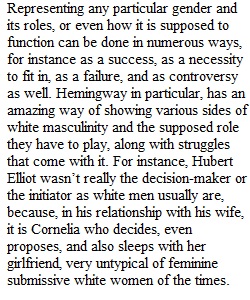


Q These days, Hemingway has become a kind of punching bag for his representations of patriarchal white masculinity. Some people have argued that he represents men as victims to create sympathy for the loss of power white men have experienced in the twenty-first century. Is this fair? Why or why not? Is there more to Hemingway’s stories than just another white guy who upholds the patriarchy and ignores the experiences of the rest of the world? Can these stories give us real insight into how hard it is to a be man in patriarchy? Or is there some other way we should approach them? What value do you see in Hemingway’s representation of masculinity, if any? Explain your answer by posting a 300-word response that refers to two stories and/or interchapters (the short pieces at the head of each chapter) other than “A Very Short Story,” “Indian Camp” and “Three-Day Blow.” (You can still refer to these, but you must also refer to two other stories)
View Related Questions